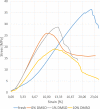The influence of different sample preparation on mechanical properties of human iliotibial tract
- PMID: 32908171
- PMCID: PMC7481782
- DOI: 10.1038/s41598-020-71790-5
The influence of different sample preparation on mechanical properties of human iliotibial tract
Erratum in
-
Author Correction: The influence of different sample preparation on mechanical properties of human iliotibial tract.Sci Rep. 2021 Jan 25;11(1):2673. doi: 10.1038/s41598-021-81980-4. Sci Rep. 2021. PMID: 33495496 Free PMC article. No abstract available.
-
Author Correction: The influence of different sample preparation on mechanical properties of human iliotibial tract.Sci Rep. 2021 May 11;11(1):10404. doi: 10.1038/s41598-021-89952-4. Sci Rep. 2021. PMID: 33976345 Free PMC article. No abstract available.
Abstract
In the run-up to biomechanical testing, fresh human tissue samples are often frozen in order to inhibit initial decomposition processes and to achieve a temporal independence of tissue acquisition from biomechanical testing. The aim of this study was to compare the mechanical properties of fresh tissue samples of the human iliotibial tract (IT) to fresh-frozen samples taken from the same IT and those modified with different concentrations of Dimethylsulfoxide (DMSO) prior to freezing. All samples were partial plastinated and destructive tensile tests were conducted with a uniaxial tensile test setup. A plastination technique already established in the laboratory was modified to improve the clamping behaviour of the samples. Material failure was caused by a gradual rupture of the load-bearing collagen fibre bundles. Contrary to our expectations, no significant difference was found between the tensile strength of fresh and fresh frozen specimens. The addition of 1 wt% DMSO did not increase the tensile strength compared to fresh-frozen samples; an addition of 10 wt% DMSO even resulted in a decrease. Based on our findings, the use of simple fresh-frozen specimens to determine the tensile strength is viable; however fresh specimens should be used to generate a complete property profile.
Conflict of interest statement
The authors declare no competing interests.
Figures







Similar articles
-
Effect of storage on tensile material properties of bovine liver.J Mech Behav Biomed Mater. 2014 Jan;29:339-49. doi: 10.1016/j.jmbbm.2013.09.022. Epub 2013 Oct 8. J Mech Behav Biomed Mater. 2014. PMID: 24148876
-
Irradiation at 11 kGy conserves the biomechanical properties of fascia lata better than irradiation at 25 kGy.Clin Biomech (Bristol). 2018 Dec;60:100-107. doi: 10.1016/j.clinbiomech.2018.10.016. Epub 2018 Oct 12. Clin Biomech (Bristol). 2018. PMID: 30340149
-
Cryopreservation versus fresh frozen meniscal allograft: A biomechanical comparative analysis.J Orthop Surg (Hong Kong). 2017 Sep-Dec;25(3):2309499017727946. doi: 10.1177/2309499017727946. J Orthop Surg (Hong Kong). 2017. PMID: 28844199
-
Can we trust ex vivo mechanical testing of fresh--frozen cadaveric specimens? The effect of postfreezing delays.J Orthop Trauma. 2011 Aug;25(8):459-61. doi: 10.1097/BOT.0b013e318225b875. J Orthop Trauma. 2011. PMID: 21738060
-
Tensile mechanical properties of vitrified porcine menisci are superior to frozen and similar to fresh porcine menisci.J Biomech. 2022 Oct;143:111277. doi: 10.1016/j.jbiomech.2022.111277. Epub 2022 Aug 29. J Biomech. 2022. PMID: 36063771
Cited by
-
Shape or size matters? Towards standard reporting of tensile testing parameters for human soft tissues: systematic review and finite element analysis.Front Bioeng Biotechnol. 2024 Mar 26;12:1368383. doi: 10.3389/fbioe.2024.1368383. eCollection 2024. Front Bioeng Biotechnol. 2024. PMID: 38600944 Free PMC article.
-
Approach to standardized material characterization of the human lumbopelvic system-Specification, preparation and storage.PLoS One. 2023 Aug 3;18(8):e0289482. doi: 10.1371/journal.pone.0289482. eCollection 2023. PLoS One. 2023. PMID: 37535581 Free PMC article.
-
Characterization of main pulmonary artery and valve annulus region of piglets using echocardiography, uniaxial tensile testing, and a novel non-destructive technique.Front Cardiovasc Med. 2022 Aug 26;9:884116. doi: 10.3389/fcvm.2022.884116. eCollection 2022. Front Cardiovasc Med. 2022. PMID: 36093160 Free PMC article.
-
The effect of gastrocnemius resection on knee flexion in a total knee arthroplasty model.Arch Orthop Trauma Surg. 2022 Oct;142(10):2503-2511. doi: 10.1007/s00402-020-03695-x. Epub 2021 Mar 26. Arch Orthop Trauma Surg. 2022. PMID: 33772361
References
Publication types
MeSH terms
Substances
LinkOut - more resources
Full Text Sources

